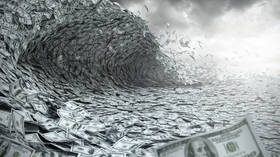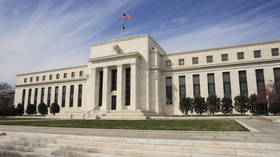Apocalypse now or later? What the stock market collapse means and what the Fed fears most
The American economy is too financialized to withstand any sustained drop in asset prices
It’s carnage out there in the markets, and things have been moving with the force of a tsunami.
Japan’s Nikkei 225 plunged more than 12% on Monday in what was the biggest single-day drop since ‘Black Monday’ in 1987. As of this writing, the Dow has dropped some 900 points, while the Nasdaq has cratered 3% in what has turned out to be a global market rout.
The triggers for the selloff are clear enough and have been well covered in the financial media. Friday’s disappointing US jobs report ignited fears of a US recession. The once-hot but overly leveraged and overhyped AI trade has gone sour, which has led to a bloodbath for tech stocks.
Largely responsible for the latter development is the breaking of the massive dollar-yen carry trade – where investors were borrowing cheaply in yen and investing in higher-yielding US assets. This can be thought of roughly as a big interest-rate arbitrage: Borrow at low rates and lend (invest) at higher rates. But when the Bank of Japan raised rates on July 31 and, perhaps even more importantly, signaled more hikes to come, a massive capitulation in these carry-trade positions ensued. This has reverberated through markets and led to a lot of margin calls. And since investors often have to sell other assets to meet margin calls, it creates even more selling pressure.
Predicting where markets may be headed in the coming days and weeks is a hazardous endeavor that I won’t venture. Many investors are of course trying to catch the proverbial ‘falling knife’ – meaning buying in during or immediately after a sharp selloff. A number of analysts are already saying that the panic is overblown and things will soon stabilize. If I had high conviction about how things will shape up over the short term, I would simply trade the market, not write about it.
So instead of shooting in the dark with a forecast, let’s figure out how to think about what’s going on. And it’s always good to step back a bit and try to find the bird’s eye view in the midst of turmoil. First, there’s the obvious: This is really a fairly classic instance of a positioning unwind rather than a response to an economic shock. A lot of equity investors got in too deep chasing the bubble in tech stocks – and a lot of these unfortunate folks were borrowing cheaply in Japanese yen to do so (see above about the carry trade). There are a lot of margin calls going on, a lot of forced liquidations on leveraged positions – and probably a lot of wives securing the windows in the high rises.
Assuming this doesn’t blow over quickly, what’s really important to look at is how the market’s perception of the Federal Reserve’s next steps evolves – and then what those steps turn out to be. This is not so much because the Fed is omnipotent, but because this is where the chaos of the moment intersects with some of the deep and structural features of the US economy.
The Fed kept interest rates on hold at its July meeting while hinting strongly at a rate cut in September. Many analysts believe the US central bank has waited too long to bring rates back down after the series of post-pandemic hikes aimed at cooling inflation. Market expectations of upcoming interest rate cuts had been moving sharply higher even prior to recent events.
However, the market meltdown has propelled this conversation into overdrive. If as recently as last Wednesday futures tied to the federal funds rate were showing an 87% chance of a 25 basis-point cut – the smallest possible move – in September, investors are now pricing in about 55 basis points of easing at September’s meeting and 100 basis points by November’s. In other words, the market sees about a 20% chance of an emergency rate cut.
Can Friday’s downbeat employment report really be that much of a game-changer for the US economy? It certainly moved the needle but it can hardly explain such a radical shift. What is really behind such pricing – not to mention calls for an emergency cut – is a belief that the Fed needs to step in and rescue the markets.
This speaks volumes about how the Fed is perceived to have, in addition to its official mandate of price stability and full employment, an unspoken mandate of market stability. This hidden third mandate even has a name: the ‘Fed put’.
In finance, a ‘put’ is a contract that gives its owner the right to sell something – such as a stock, bond, or commodity – at a predetermined price, regardless of the market price. Think of it as a guarantee – no matter how far the market has fallen, you can unload your asset for the set price.
But the term has come to be used in a more general sense. Applied to the Fed, it means that there is a belief that whenever the economy or markets turn south, the Fed will swoop in and cut interest rates or print money to provide a boost. Such a policy is, of course, officially denied, but many investors think that there is a floor underneath markets, just as there is for an asset with a ‘put’ option. This has been an important source of what may seem like unfounded and never-wavering confidence in the US stock market that has prevailed with few exceptions since the late 1990s.
The Fed has, in fact, shown time and again that it is ready to intervene in various ways – directly or opaquely – whenever the stability of financial markets is threatened.
The entire narrative we have been seeing around the Fed over the last 48 hours speaks to a sturdy belief that some version of the ‘Fed put’ remains in place. While the Fed is unlikely to actually go so far as to summon an emergency meeting to cut rates – doing so would be an overt display of panic – it will very likely aggressively talk markets down from the precipice by all but promising hefty rate cuts for the remainder of the year. And if things really get out of hand in markets, a more forceful intervention is nearly guaranteed.
So let’s take this a step further and try to understand what really underlies this invisible commitment to markets. Is this just banal corruption on the part of stock-holding Fed committee members? No. That’s not how it works.
What really underlies this is that the Fed is simply responding to a deep structural distortion of the economy that is in plain view but often insufficiently appreciated. The US economy is so financialized and so leveraged, and so many Americans (particularly the elite classes) are so dependent on the prices of financial assets for their wealth that a sustained and long-term drop in markets would simply be catastrophic. If a large part of GDP is connected, one way or another, to asset prices, movements in markets take on an importance far beyond the fortunes of Wall Street players.
To find a rather remarkable illustration of this, look no further than the extent to which even the tax base is dependent on financial markets. The year 2023 was a pretty good one for the economy, whether judged by the labor market or growth figures. Nevertheless, total receipts of the federal government were down about 7% from 2022. How is that possible in a year in which not only did the economy grow but personal income actually increased? The answer: Individual income tax receipts actually dropped despite rising incomes because capital gains realizations from the previous year were lower (capital gains realizations are merely the profits on investments sold). The reason for the decline in capital gains is that in 2022 US stocks had their worst year since 2008.
Market instability is therefore the one thing the Fed – and the powers that be in Washington and New York – fear most. They will entertain any manner of short-term thinking, introduce any moral hazard, and inflate and reinflate any bubble to keep the markets humming. If the price of this is inflation or even more perverse distortions in the economy, then so be it.
Meanwhile, stocks have been a critical weapon in the arsenal of America’s wealthier classes for countering the effects of inflation. Whereas people on fixed incomes or those whose wage increases are not keeping up with price growth are watching their purchasing power erode, the investment class is able to beat inflation through high asset prices. What’s a 10% increase at the grocery store if your portfolio is up 20%? This goes a long way toward explaining the increasing bifurcation in the American economy between the haves and the have-nots.
Whatever may come of the current volatility, there are good reasons to believe that the apocalypse is not nigh. When the bill for all the can-kicking and bubble-inflating finally does come due, it almost certainly won’t be as a stock-market collapse. Stock markets, after all, can always be reinflated through money printing, and it’s hard to imagine the Fed standing aside while markets spiral into oblivion. Markets, which represent the interests of the class of privileged people who benefit from rising asset prices, want easy money to continue climbing. And such people tend to get what they want for longer than any logic would dictate they should.
In nominal terms, stock markets can go up indefinitely, with the occasional hiccups smoothed out by more liquidity. The question simply becomes – at what cost? Will there still be a functioning bond market? Where will inflation be? Will the currency be lugged around in wheelbarrows?
What’s important to watch in the coming weeks and months is how seriously the Fed takes what is going on in markets and how much the market holds it hostage to act. There won’t be statements from the Eccles Building saying markets need to be rescued, but actions always speak louder than words. And how the Fed acts will reveal where its true priorities lie.








Comments are closed.